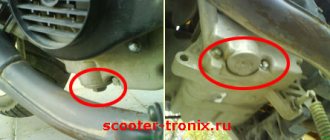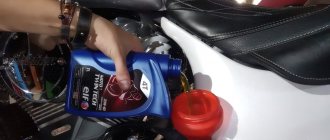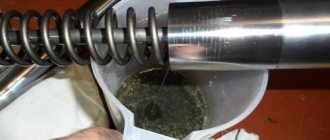Motor oil for motorcycles is an indispensable structural component of the working process of gasoline engines. The reliable operation of internal combustion engine components and parts throughout its entire service life depends on the technologically correct selection of lubricants.
If you have decided to purchase an iron horse and are in the search stage, professionals specializing in the sale of motorcycles in Moscow and the region will help you with this.
Now let’s talk about what types of motorcycle oil there are and the general requirements for them.
Types of oils
Oil for an internal combustion engine consists of two main components - a base (base raw material) and modifying additives. The technical characteristics of oil compositions largely depend on the properties of the base compositions.
Chemical additives serve only to regulate and improve certain operational parameters.
Based on the production method, the basic components are divided into several categories:
- Mineral oils obtained by processing and subsequent rectification of petroleum products.
- Synthetic – products of the synthesis of hydrocarbon compounds (producer gas, etc.).
- Semi-synthetic - basic modifications made from synthetic (25%) and mineral raw materials.
The chemical structure of a mineral resource is based on the primary quality of the oil, how it is distilled, and the level of filtration. The mineral base component is the cheapest product for processing petroleum feedstock.
It is characterized by variable viscosity, unstable temperature parameters, low resistance to oxidative processes and high volatility.
Synthetic oil has stable viscosity properties and a lower pour point compared to a mineral base, which makes starting the engine much easier in winter.
The oil film formed on the surface of the mechanism parts is not destroyed when the engine operates at extreme turbo modes.
Semi-synthetic is a chemical composition containing 20–40% synthetic base oil in its structure. There are no standards or recommendations for the percentage of components in the solution.
In terms of performance characteristics, these liquids occupy an intermediate level between synthetic and mineral compounds. The price of semi-synthetic products is almost half that of synthetics.
Selecting the viscosity level
The main parameters that are indicated on the canister of lubricating fluid are viscosity and temperature. For Japanese 250cc and 400cc bikes (eg Honda CB 400 SF) the 10W-40 grade is recommended.
The decoding is simple:
- 10 – temperature index at which the free movement of components through the oil channels will occur. Covers a temperature range from minus 20 to plus 35.
- 40 – viscosity when the engine heats up.
If the motorcycle is used in hot weather or off-road conditions, and dirt constantly sticks to the parts, which also increases the internal temperature, you can opt for 10W-50. But the most important thing before buying is to read the manual and follow the manufacturer’s recommendations.
General requirements
Motor oil is capable of performing all the functions assigned to it only if the design of the engine and its operational characteristics strictly correspond to the declared properties of lubricating fluids. This is the main condition that must be observed to increase the reliability of the internal combustion engine.
Modern oil compositions should have the following characteristics:
- High cleaning ability in relation to insoluble solid deposits (carbon deposits, scale, etc.), as well as timely and complete removal of them from the friction zone.
- Stable thermal and oxidative stability.
- Be compatible with sealing parts (rubber, polymers, etc.).
- Be characterized by low foaming and volatility properties (exhaust, fumes).
- Seal the temperature gaps between the elements of the piston group and limit the exit of exhaust gases through the combustion chamber as much as possible.
- Provide reliable protection of mechanism parts from corrosion.
- Remove heat from the cylinder block.
The oil film on the surface of rubbing parts must have sufficient viscosity under extreme temperature conditions, and be able to provide optimal protection to metal surfaces under conditions of boundary friction and exposure to acids formed during fuel combustion.
What brand of oil is best to use?
Today, every brand has a motorcycle oil with unique properties that guarantees the best engine protection, and its price-quality ratio is the most optimal.
However, you should trust facts, not advertising slogans. For example, recommendations from major manufacturers and real reviews of equipment owners about motor oil for motorcycles will be more significant than beautifully written phrases from the manufacturer.
One way or another, you initially need to be guided by the type of engine, characteristics and specifications, and only then look at the manufacturer’s promises.
Application specifics
Motorcycle gasoline engines are divided into two- and four-stroke mechanisms. The operation schemes of each device are strictly individual.
The difference is that the lubrication of the rubbing parts of a two-stroke design is carried out using a fuel mixture, into which motor oil is added when pouring gasoline. As the motorcycle moves, the oil burns along with the fuel and does not require regular replacement.
Four-stroke engines are equipped with an autonomous lubrication system. Oil is poured into the engine crankcase, and it does not burn during operation of the unit. The main feature of this design is that the crankcase is a common reservoir for the gearbox, gearbox and clutch.
Therefore, when choosing lubricating fluids for a four-stroke engine, you need to take into account the properties of all three mechanisms.
The technical differences of both devices require the presence of motor oils of different composition in the lubrication systems of the units.
Hi all! The season is coming, which means THAT, which means again questions about oil! I think the article will be on topic. Let me make a reservation right away that we will talk exclusively about civilian uses of motorcycles, and therefore engine operating modes! And let’s say right away – NO! You CANNOT pour whatever you want into your motorcycle! Below the cut is traditionally a video, for lazy people like me, as well as text and pictures for those who like to read! We will not go into details of the theory of operation of internal combustion engines, but will try to consider the topic from a logical point of view accessible to everyone (I hope).
We will talk about motorcycles with a clutch in an oil bath, the so-called wet clutch. For motorcycles with a dry clutch, everything that is true for conventional car engines is true, and we will not consider them here. Most of the information presented in this article was taken from THIS resource! I highly recommend checking it out. Spend 1-2 hours of free time and if you are the owner of not only a motorcycle, but also a car, you DEFINITELY benefit from it!
And so let's go. Although no, stop. One more important note is needed. The topic of engine oil is a matter of faith for many! After all, nothing else can explain when people buy branded oils from Toyota, Nissan or BMW! PEOPLE, AWWWW, these manufacturers DO NOT have their own creameries!!! They pour mass-produced Castrol or Shel oils into their branded canisters and sell them to you at a branded markup! The same goes for specialized MOTO oils! Do you still buy branded/motor oils? Then we go to you! Now to the point. Let's turn to logic! What makes a motorcycle move? Yes, it's an internal combustion engine! Are motorcycle internal combustion engines fundamentally different from car engines? The answer will be quite obvious – no, they don’t! And this is the first important conclusion, which means oils for automobile gasoline engines MUST be suitable for motorcycle engines! Now let’s look at the engine options on motorcycles, essentially there are only 2 of them. These are V-twin and in-line (opposite engines - exhale, everything is true for you as for in-line engines).
Let's start with something simple. V-twin . It always touches me when a person owns a cruiser that was produced in the early or mid-90s of the last century (or any modern one), i.e. almost 30 years ago, he starts asking on forums or in club topics - Guys, what should I put in the engine? Will such and such oil with such and such tolerances be suitable? And he also gives a link to some cool brand with the latest approvals, where a liter costs 700 rubles.
No, are you seriously asking this? Is it so difficult for you to just think that it’s easier to go on the Internet, write a post there, give a link to some oil and wait for an answer!?
Friend! Aw!!! You have a V-twin! Which appeared in 1889, almost 130 years ago!!!
AU!!! What recent clearances are you concerned about? V-twin is a low-speed, usually derated internal combustion engine! This design is over 130 years old!!! Nothing fundamentally changed about it! The carbs were replaced by injectors, the number of valves increased, etc. But the same piston still moves inside the cylinder! Now let’s pay attention to the question: what approvals did the oils have, say, 30 or 20 years ago?
These were ordinary MINERAL automobile (oh, horror, who would have thought) oils! You can pour into your V-twin what your grandfather poured into his Muscovite 412! If you have a V-twin, all you need to know about the oil in your engine is its viscosity! As a rule, this is 10w40 (but it’s better to check in the manual)! And you can easily pour simple mineral water without overpaying for any brands, and it’s even more pointless to pour synthetics or oil with the MOTO prefix, for which you will be charged extra money.
Let's move on to a little more complex - in-line engines . If your in-line engine does not spin above 5-7 thousand, then you have exactly the same situation as with the V-twin. Simply because you have exactly the same internal combustion engine, but only the cylinders are located in space not much differently! And believe me - the oil that you pour into the engine knows NOTHING about HOW the cylinders are located in your engine! (unexpected, right?) But if your engine spins above 10 thousand revolutions and you like to give it a long time to cut off, then there are nuances. In this case, you are better off using high-quality synthetic oils on a POE (polyol ether) basis (why will be described below) with the same viscosity as indicated in your manual. High-quality oils can be selected HERE.
Now the actual rationale for all of the above! We need to understand what exactly leads to a deterioration in the lubricating and detergent properties of the oil. In general there are 2 main reasons. 1. This is the temperature at which the oil operates in your engine. Temperature kills oil the fastest. The higher the temperature, the faster the oil “ages” losing its properties. Therefore, on high-speed (read - hot) engines (by hot we mean engines in which the oil has a temperature above 100 degrees most of the time while the engine is running), it is better to use high-quality synthetic oils; they resist elevated temperatures longer and retain their properties longer, holding them more reliably in themselves additives and not allowing them to fall out in the form of hard ash sand or deposits, such as in the picture below.
2. The second reason is the clutch. Most motorcycles have a wet clutch, i.e. it is washed with the same oil as the entire engine, as a result, clutch wear products enter and circulate throughout the engine. It is clear that this does not bring him much benefit either. I think this is one of the reasons why on not very hot V-twins it is recommended to change the oil not once every 10 thousand like on a car, but once every 6-8 thousand.
Now let’s talk about N’T POUR INTO MOTO ! (applies only to motorcycles with a wet clutch) These are oils with friction modifiers (Molybdenum, graphite, etc.), the friction modifiers themselves separately, metal-clad additives, as well as mineral-clad additives. What are friction modifiers? These are substances that promote easier sliding of surfaces rubbing against each other, because they, as their name implies, modify friction - reducing it, which is clearly beneficial for the engine, this allows it to reduce wear, and also, just as importantly, allows it to spin up faster! Metal cladding additives are substances that use very, very small particles of soft metals, such as copper. They are used so that the engine itself rubs them into those places where there are some micro-irregularities on the cylinders and other rubbing surfaces, thereby leveling these surfaces. Roughly speaking, this is putty for the walls inside the engine. Mineral-cladding additives consist of very, very small particles of special minerals, which friction couples in engines rub over the surface, thereby creating a protective surface on the metal, also reducing the coefficient of friction. You can read more details and with pictures HERE. Using all these things that are good for the engine will most likely kill your clutch and it will not work as it should (it will simply slip due to the work of friction modifiers).
Brief summary . Car and motorcycle engines have no fundamental differences! This means you CAN pour into your motorcycle any automobile oil for gasoline engines of the viscosity specified in your manual! In motorcycle engines with a wet clutch, you CANNOT pour oils that ALREADY contain friction modifiers, and you also can’t pour friction modifiers and cladding additives themselves.
Anyone who wants to delve into the topic in more detail, I highly recommend THIS resource! And THIS topic in particular!
Thanks for reading and watching the video! I hope it was interesting and useful!
PS The information is for informational purposes only and is intended for people who are not particularly knowledgeable about the topic of oil. I didn’t drip deep on purpose, so as not to overload.
PPS Maybe we can try without fuss!?
Gasoline oil for two-stroke motorcycle engine
The structure of lubricants for a two-stroke motorcycle engine is subject to the following operational requirements:
- The lubricant must burn completely in the engine cylinders, without forming soot, ash or other by-products on the chamber walls.
- When mixing fuels and lubricants, they must completely dissolve in each other.
- Protect the surface of rubbing parts from corrosion, premature wear and overheating.
It is recommended to mix gasoline and oil in a separate clean container. The ratio of components is selected empirically at the rate of 1:20 or 1:50; a more accurate consumption is indicated in the motorcycle operation and maintenance instructions.
Sequence of preparation of the mixture:
- Add half the required volume of liquid to a metal canister.
- Pour in the calculated amount of oil and stir.
- Fill the tank with the remaining fuel, shake well and pour the mixture into the gas tank.
To avoid mistakes in the dosage of products, lubricants should be purchased in transparent measuring containers with a graduated scale.
Top brands
There has long been a debate among motorcyclists about which oil is better. If we exclude domestic products, the number of brands in the motorcycle lubricant market will be relatively small. Most experts and owners of two-wheeled vehicles agree that Motul oil is the “golden mean” in terms of lubricating properties and additive content. Motul 300 V Competition oil is especially popular among racers - “synthetic” with moderate lubricating properties, which allows you to achieve maximum power of the power unit from the first seconds.
Shell products are a good option, but they are more likely to be counterfeited than others, so you should be especially careful when purchasing them. The main advantage of this manufacturer is a very wide range of products that are suitable for literally all types of two-wheeled vehicles. Owners of mopeds will be able to use Shell Advance Snowscooter, and for more serious two-stroke equipment it is worth stocking up on Shell Advance VSX 2. Owners of four-stroke city motorcycles prefer to use Shell Advance Racing X, and for two-stroke racing equipment Shell Advance Racing M is suitable.
Among the good brands, Castrol is also worth mentioning - the products of this manufacturer have a very high price, but almost never fail motorcycle owners. Good results are shown by products from such manufacturers as:
- Valvoline;
- Liqui Moly;
- Esso.
Texaco and BP oils have average performance, although they are quite sufficient for low-power equipment. Among the brands that should never be chosen are Ravenol and Motorex, since their oils are only suitable for scooters manufactured in the 90s and early 2000s.
There are often recommendations to pour regular automobile oil into motorcycle engines, since it has better properties. However, such advice will be completely irrelevant for owners of modern powerful equipment. With significant acceleration, the oil is pushed to the rear wall of the engine, making it difficult for it to enter the intake receiver. Automotive lubricants in motorcycle engines foam quite strongly, which leads to oil starvation and the appearance of scoring on the cylinder walls. The exception is domestic motorcycles and foreign low-power equipment (up to 20–30 horsepower), although here too the use of automotive lubricant is a risky step.
Oil for four-stroke motorcycle engines
Modern four-stroke engines are high-tech gasoline units with air and oil cooling of the cylinder block. The main parts of the transmission are lubricated in the engine crankcase.
The choice of oil for such a motorcycle is carried out taking into account increased operational requirements. This:
- the volume of modifying additives in the lubricant mixture should be 25% or more;
- resistance of emulsions to changes in viscosity characteristics when operating in different temperature conditions;
- easy engine starting;
- resistance to thermal-oxidative processes;
- wear resistance;
- anti-seize qualities, etc.
The most important points
Even if you buy the highest quality oil, this will not necessarily protect you from engine damage. To extend the life of the power unit, it is worth changing the lubricant regularly - at least every 5-6 thousand kilometers. You also need to monitor the condition of the filters and pump, since they are responsible for the normal circulation of oil inside the engine and gearbox. Owners of two-stroke motorcycles need to pay attention to how much oil to add to gasoline and when to change the established proportion. Only if you follow all the rules and purchase high-quality oil, the motorcycle will last for many years and will not require serious repairs.
Classification of oils
The most common certification system for liquid lubricants is the American SAE structure. According to the standards of this organization, the viscosity of lubricants is indicated by relative parameters that reflect the conditional value of the viscosity characteristics.
The larger the number at the beginning of the marking (5 or 25W), the better the viscosity of the product.
There are three main groups of lubricants:
- summer;
- winter;
- all-season.
Using a motorcycle in winter is very rare, however, oils from this group are present on the market in large quantities. The marking, which includes the English symbol W (“winter”), belongs to winter types of oils (for example, 15W40). The number after the letter indicates the degree of viscosity of the liquid.
Summer motorcycle lubricant is not particularly popular. They are designated SAE 20–40. The numbers 50, 60 units (only in designations for summer brands) belong to transmission compositions and are not used in engines.
All-season lubricants are lubricants obtained by adding improving modifying additives to their composition. This production technology allows you to start and operate a motorcycle engine in any temperature conditions.
For example, SAE 10W50:
SAE is a mandatory letter abbreviation for all-season oils;
10 – temperature limit below which the oil freezes;
50 – viscosity level;
W – indicates the possibility of using the product in winter.
For four-stroke and two-stroke engines, the indices 4T and 2T are added to the main product designation, respectively. Mixing and replacing these types of oils with each other is strictly prohibited.
Checking the engine and warming up
- After replacing the lubricant, the engine should be warmed up - to do this, start it and leave it for 15 minutes, then measure the amount of lubricant.
- All measurements should be carried out using a special device - a probe.
- It is also recommended to take into account that the amount of lubricant poured into a scooter or any other small motorcycle should be greater than the maximum value.
- You need to buy 3-4 liters of oil for a scooter, which will make it possible to add additional lubricating fluid if necessary.
Motorcycle oil viscosity and other quality indicators
Viscosity is the most important indicator influencing the choice and quality of petroleum products. This parameter may change its value if operating temperature conditions change.
To successfully start a cold engine at low temperatures, the viscosity coefficient must be within limits that ensure free rotation of the crankshaft and easy supply of oil fluid through the channels of the engine lubrication system.
Under extreme operating conditions, on the contrary, the mixture must have a high index, otherwise it will not be able to form a durable protective coating between the contacting surfaces, and also create the required pressure in the system.
Viscosity Index Characteristics
This is a value that shows the effect of engine temperature on the viscosity of oils. Digital index indicators are relative values. The higher the number, the higher the temperature limit of the liquid used.
For mineral varieties, without improving additives, the index value is 80–100. Lubricants with viscosity modifiers and synthetic components are in the range of 125–150 units. For deeply purified materials, the coefficient can rise to 200.
Flash point
This parameter characterizes the presence of low-boiling components in the lubricating composition; its value affects the volatility of the product during operation. For benign materials, this indicator ranges from 210–225°C.
In low-quality oils, mixtures with reduced viscosity quickly burn and evaporate, which causes increased resource consumption and a decrease in its temperature characteristics.
Pour point
This is an indicator that regulates the degree of mobility of the oil fluid. The setting temperature is characterized by a rapid increase in viscosity and the release of crystallized paraffin from homogeneous mixtures.
At the end of this process, the oil becomes hard and unable to perform any functions.
Base number
TBN or alkaline coefficient shows the ability of the oil used to neutralize acidic components formed during engine operation. The alkaline index for gasoline engines is 8–9 units.
Over time, during operation, the neutralizing components lose their properties. Violation of the oil change schedule can lead to contamination of the internal surfaces of the unit and acid corrosion of the metal.
Specifications
| Density at 15 °C, kg/m3 | 876,8 |
| Kinematic viscosity at 100 °C, mm2/s | 10,76 |
| Kinematic viscosity at 40 °C, mm2/s | 81,36 |
| Viscosity index | 118 |
| Flash point in an open crucible, °C | 158 |
| Pour point, °C | -42 |
| Quality classes | JASO FD/ISO-L-EGD, JASO FB/API TC |
| Tolerances | Rotax 253, Piaggio Hexagon |
Choosing motorcycle oil, tips and tricks
In the domestic automobile market there are many types of motorcycle oils in different price categories. Synthetics are more expensive, mineral water is cheaper. Recently, they have even begun to produce ready-to-use lubricants - diluted according to the standards and in the appropriate dosage.
How to choose the right modification. First of all, you need to use only the oil for your motorcycle that is indicated in the unit’s passport. The use of lubricants not specified in the maintenance instructions is strictly prohibited.
All motorcycle manufacturers must indicate the type of recommended oil in the accompanying documents. Markings may also be present on service stickers or on the drain plug in the engine crankcase.
Common Myths
You can often hear that it is best to fill air-cooled motorcycles with the thickest oil possible, like SAE 10W-60. In fact, it does more harm than good.
It was already mentioned above that the engine is largely lubricated by splashing. With thicker oil, of course, the engine will run quieter, the oil pressure will be more stable, but the wear of many components will accelerate. Thus, the valve drive mechanisms in lower engine engines will begin to suffer, and less oil will get into the cylinders if the engine does not have forced oil supply channels. As a result, trying to improve the engine's performance will only harm it. The oil viscosity recommended by the manufacturer is best suited for it.











